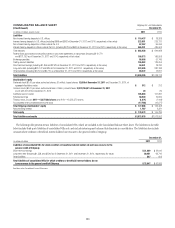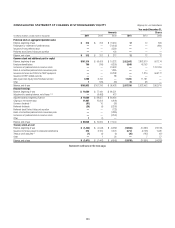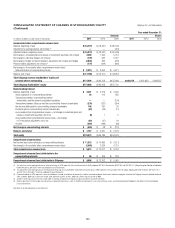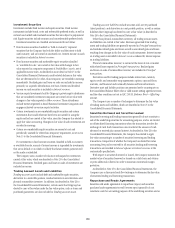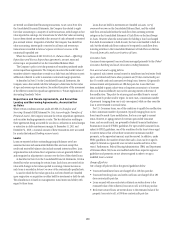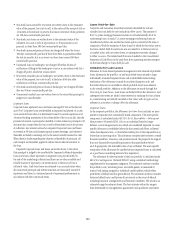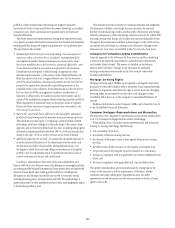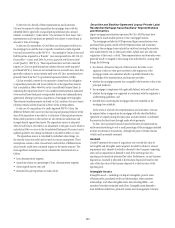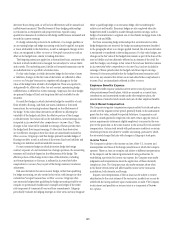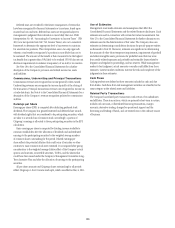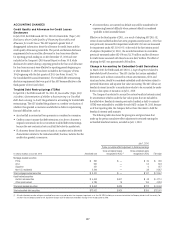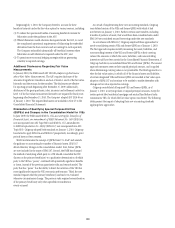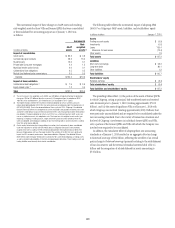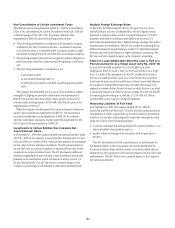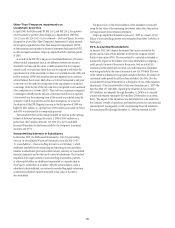Citibank 2011 Annual Report Download - page 163
Download and view the complete annual report
Please find page 163 of the 2011 Citibank annual report below. You can navigate through the pages in the report by either clicking on the pages listed below, or by using the keyword search tool below to find specific information within the annual report.141
of current conditions, including general economic conditions, specific
industry and geographic trends, and internal factors including portfolio
concentrations, trends in internal credit quality indicators, and current and
past underwriting standards.
For both the asset-specific and the statistically based components of the
Allowance for loan losses, management may incorporate guarantor support.
The financial wherewithal of the guarantor is evaluated, as applicable,
based on net worth, cash flow statements and personal or company financial
statements which are updated and reviewed at least annually. Citi seeks
performance on guarantee arrangements in the normal course of business.
Seeking performance entails obtaining satisfactory cooperation from the
guarantor or borrower to achieve Citi’s strategy in the specific situation. This
regular cooperation is indicative of pursuit and successful enforcement of
the guarantee; the exposure is reduced without the expense and burden of
pursuing a legal remedy. Enforcing a guarantee via legal action against the
guarantor is not the primary means of resolving a troubled loan situation
and rarely occurs. A guarantor’s reputation and willingness to work with
Citigroup is evaluated based on the historical experience with the guarantor
and the knowledge of the marketplace. In the rare event that the guarantor
is unwilling or unable to perform or facilitate borrower cooperation, Citi
pursues a legal remedy. If Citi does not pursue a legal remedy, it is because
Citi does not believe that the guarantor has the financial wherewithal to
perform regardless of legal action or because there are legal limitations
on simultaneously pursuing guarantors and foreclosure. A guarantor’s
reputation does not impact our decision or ability to seek performance under
the guarantee.
In cases where a guarantee is a factor in the assessment of loan losses, it
is included via adjustment to the loan’s internal risk rating, which in turn
is the basis for the adjustment to the statistically based component of the
Allowance for loan losses. To date, it is only in rare circumstances that an
impaired commercial or commercial real estate (CRE) loan is carried at a
value in excess of the appraised value due to a guarantee.
When Citi’s monitoring of the loan indicates that the guarantor’s
wherewithal to pay is uncertain or has deteriorated, there is either no
change in the risk rating, because the guarantor’s credit support was never
initially factored in, or the risk rating is adjusted to reflect that uncertainty
or deterioration. Accordingly, a guarantor’s ultimate failure to perform or
a lack of legal enforcement of the guarantee does not materially impact
the allowance for loan losses, as there is typically no further significant
adjustment of the loan’s risk rating at that time. Where Citi is not seeking
performance under the guarantee contract, it provides for loans losses as if
the loans were non-performing and not guaranteed.
Consumer loans
For Consumer loans, each portfolio of non-modified smaller-balance,
homogeneous loans is independently evaluated by product type (e.g.,
residential mortgage, credit card, etc.) for impairment in accordance
with ASC 450-20. The allowance for loan losses attributed to these loans
is established via a process that estimates the probable losses inherent in
the specific portfolio. This process includes migration analysis, in which
historical delinquency and credit loss experience is applied to the current
aging of the portfolio, together with analyses that reflect current and
anticipated economic conditions, including changes in housing prices and
unemployment trends. Citi’s allowance for loan losses under ASC 450-20 only
considers contractual principal amounts due, except for credit card loans
where estimated loss amounts related to accrued interest receivable are also
included.
Management also considers overall portfolio indicators, including
historical credit losses, delinquent, non-performing, and classified loans,
trends in volumes and terms of loans, an evaluation of overall credit quality,
the credit process, including lending policies and procedures, and economic,
geographical, product and other environmental factors.
Separate valuation allowances are determined for impaired smaller-
balance homogeneous loans whose terms have been modified in a troubled
debt restructuring (TDR). Long-term modification programs as well as
short-term (less than 12 months) modifications originated from January 1,
2011) that provide concessions (such as interest rate reductions) to borrowers
in financial difficulty are reported as TDRs. In addition, loans included in
the U.S. Treasury’s Home Affordable Modification Program (HAMP) trial
period at December 31, 2011 are reported as TDRs. The allowance for loan
losses for TDRs is determined in accordance with ASC 310-10-35 considering
all available evidence, including, as appropriate, the present value of the
expected future cash flows discounted at the loan’s original contractual
effective rate, the secondary market value of the loan and the fair value
of collateral less disposal costs. These expected cash flows incorporate
modification program default rate assumptions. The original contractual
effective rate for credit card loans is the pre-modification rate, which may
include interest rate increases under the original contractual agreement with
the borrower.
Where short-term concessions have been granted prior to January 1, 2011,
the allowance for loan losses is materially consistent with the requirements of
ASC 310-10-35.
Valuation allowances for commercial market loans, which are classifiably
managed Consumer loans, are determined in the same manner as for
Corporate loans and are described in more detail in the following section.
Generally, an asset-specific component is calculated under ASC 310-10-35
on an individual basis for larger-balance, non-homogeneous loans that are
considered impaired and the allowance for the remainder of the classifiably
managed Consumer loan portfolio is calculated under ASC 450 using a
statistical methodology, supplemented by management adjustment.
Reserve Estimates and Policies
Management provides reserves for an estimate of probable losses inherent in
the funded loan portfolio on the balance sheet in the form of an allowance
for loan losses. These reserves are established in accordance with Citigroup’s
credit reserve policies, as approved by the Audit Committee of the Board
of Directors. Citi’s Chief Risk Officer and Chief Financial Officer review
the adequacy of the credit loss reserves each quarter with representatives
from the risk management and finance staffs for each applicable business
area. Applicable business areas include those having classifiably managed




